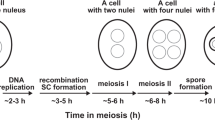Abstract
Microfilament bundles (MFBs) of F-actin were observed by fluorescence microscopy in cells ofSpirogyra treated with rhodamine-phalloidin. Four types of MFBs could be recognized on the basis of locality and appearance: those dispersed in the cytoplasm near the cell surface; those beneath the plasma membrane running parallel to each other; those at the edges of the chloroplast; and those surrounding the nucleus. Each type exhibited a unique behavior during the cell cycle. Microfilament bundles dispersed in the cytoplasm came together at the middle of the cell to form a fibril ring at the mitotic prophase. The fibril ring decreased in diameter, causing the development of a furrow in the protoplast that progressed from the outside to the inside. After the completion of furrowing, the MFBs in the fibril ring dispersed beneath the plasma membrane. Microfilament bundles surrounding the nucleus formed a net-like cage which became invisible at the mitotic anaphase, while MFBs seen at the chloroplast edges persisted there during the cell cycle without changing their position. Parallel MFBs running perpendicular to the long axis of the cell were seen at all stages in the cell cycle.
Similar content being viewed by others
Abbreviations
- MF:
-
microfilament
- MFB:
-
microfilament bundle
- MT:
-
microtubule
References
Aubin, J.E., Weber, K., Osborn, M. (1979) Analysis of actin and microfilament-associated proteins in the mitotic spindle and cleavage furrow of PtK2 cells by immunofluorescence microscopy. Exp. Cell Res.124, 93–109
Barak, L.S., Yocum, R.R., Nothnagel, E.A., Webb, W.W. (1980) Fluorescence staining of the actin cytoskeleton in living cells with 7-nitrobenz-2-oxa-1,3-diazole-phallacidin. Proc. Natl. Acad. Sci. USA77, 980–984
Bradley, M.O. (1973) Microfilaments and cytoplasmic streaming: Inhibition of streaming by cytochalasin. J. Cell Sci.12, 327–334
Clayton, L., Lloyd, C.W. (1985) Actin organization during the cell cycle in meristematic plant cells. Actin is present in the cytokinetic phragmoplast. Exp. Cell Res.156, 231–238
Dazy, A.C., Hoursiangou-Neubrun, D., Sauron, M.E. (1981) Evidence for actin in the marine algaAcetabularia mediterranea. Biol. Cell41, 235–238
Franke, W.W., Herth, W., van der Woude, W.J., Morre, D.J. (1972) Tubular and filamentous structures in pollen tubes: Possible involvement as guide elements in protoplasmic streaming and vectorial migration of secretory vesicles. Planta105, 317–341
Gunning, B.E.S., Wick, S.M. (1985) Preprophase bands, phragmoplasts, and spatial control of cytokinesis. J. Cell Sci., Suppl. No. 2, 157–179
Hensel, W. (1985) Cytochalasin B affects the structural polarity of statocytes from cress roots (Lepidium sativum L.). Protoplasma129, 178–187
Hoch, H.C., Staples, R.C. (1983) Visualization of actin in situ by rhodamine-conjugated phalloin in the fungusUromyces phaseoli. Eur. J. Cell Biol.32, 52–58
Hoch, H.C., Staples, R.C. (1985) The microtubule cytoskeleton in hyphae ofUromyces phaseoli germlings: Its relationship to the region of nucleation and to the F-actin cytoskeleton. Protoplasma124, 112–122
Koop, H.U. (1981) Protoplasmic streaming inAcetabularia. Protoplasma109, 143–157
Lloyd, C.W., Wells, B. (1985) Microtubules are at the tips of root hairs and form helical patterns corresponding to inner wall fibrils. J. Cell Sci.75, 225–238
Nagai, R., Rebhun, L.I. (1966) Cytoplasmic microfilaments in streamingNitella cells. J. Ultrastruct. Res.14, 571–589
Nagai, R., Hayama, T. (1979) Ultrastructure of the endoplasmic factor responsible for cytoplasmic streaming inChara internodal cells. J. Cell Sci.36, 121–136
Palevitz, B.A., Hepler, P.K. (1975) Identification of actin in situ at the ectoplasm-endoplasm interface ofNitella. J. Cell Biol.65, 29–38
Parthasarathy, M.V. (1985) F-actin architecture in coleoptile epidermal cells. Eur. J. Cell Biol.39, 1–12
Perdue, T.D., Parthasarathy, M.V. (1985) In situ localization of F-actin in pollen tubes. Eur. J. Cell Biol.39, 13–20
Pesacreta, T.C., Carley, W.W., Webb, W.W., Parthasarathy, M.V. (1982) F-actin in conifer roots. Proc. Natl. Acad. Sci. USA79, 2898–2901
Pickett-Heaps, J.D. (1967) Ultrastructure and differentiation inChara sp. I. Vegetative cells. Aust. J. Biol. Sci.20, 539–551
Quader, H., Deichgraber, G., Schnepf, E. (1986) The cytoskeleton ofCobaea seed hairs: Patterning during cell-wall differentiation. Planta168, 1–10
Schmiedel, G., Schnepf, E. (1980) Polarity and growth of caulonema tip cells of the mossFunaria hygrometrica. Planta147, 405–413
Waris, H. (1950) Cytophysiological study onMicrasterias. I. Nuclear and cell division. Physiol. Plant.3, 1–16
Williamson, R.E. (1972) A light-microscope study of the action of cytochalasin B on the cells and isolated cytoplasm of the Characeae. J. Cell Sci.10, 811–819
Yamaguchi, Y., Nagai, R. (1981) Motile apparatus inVallisneria leaf cells. I. Organization of microfilaments. J. Cell Sci.48, 193–205
Author information
Authors and Affiliations
Rights and permissions
About this article
Cite this article
Goto, Y., Ueda, K. Microfilament bundles of F-actin inSpirogyra observed by fluorescence microscopy. Planta 173, 442–446 (1988). https://doi.org/10.1007/BF00958955
Received:
Accepted:
Issue Date:
DOI: https://doi.org/10.1007/BF00958955




